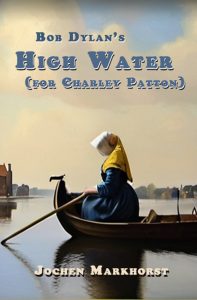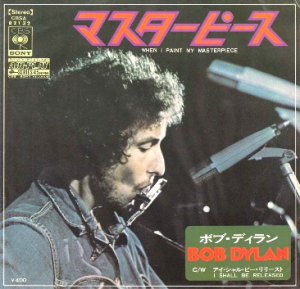“Maybe you noticed that most of my songs are traditionally rooted. I don’t do that on purpose. Charley Patton’s 30’s blues has made a deep impression on me and High Water (for Charley Patton) is, in my opinion, the best song of this record,” says Dylan at the Rome press conference, July 2001.
I do agree. Well, ex aequo with “Mississippi”, anyway. Both songs open the floodgates (no pun intended), and “High Water” belongs in the same outer category as “Desolation Row”, “Mississippi” and “I Contain Multitudes”; extremely rich, poetic, Nobel Prize-worthy musical gems. Lovely, lovely song.
(English, German and Dutch)
—————-
High Water (for Charley Patton) (2001) part 24. XXIV Via Sistina 69, Rome
by Jochen Markhorst
Hotel de la Ville is an 18th-century palazzo on Via Sistina in the heart of the Eternal City, not three hundred metres from the Spanish Steps.
If he quickly descends the stairs again and hurries back to his hotel, where some gal from the entourage of the country’s most famous Renaissance painter is already waiting, as Dylan sings in “When I Paint My Masterpiece” in 1971;
On a cold, dark night on the Spanish Stairs Got to hurry on back to my hotel room Where I’ve got me a date with Botticelli’s niece
… then an athletic, hurrying suitor can be back in less than two minutes. Going to the Colosseo the next morning (“Oh, the hours I’ve spent inside the Coliseum”-both Lyrics and the official website bobdylan.com rather stubbornly stick to a U.S. spelling of Colosseum) is also doable: a lovely half-hour morning walk. Cup of coffee on the way in the Giardini del Quirinale, perhaps admire Michelangelo’s masterpiece Moses in the Basilica di San Pietro in Vincoli, and when we’re back outside we can already see the Colosseum shining.
Anyway, in that five-star hotel on the Via Sistina, Dylan, after a somewhat awkward, cold start, gives a relaxed, increasingly cheerful press conference on 23 July 2001. The small group of thirteen chosen reporters gradually manifest themselves more as fanboys than critical journalists, but nevertheless – or perhaps precisely therefore – manage to extract one fascinating quote after another revealing fact from the protagonist.
The press conference is the next stage in an orchestrated, actually undylanesque promotional campaign for the forthcoming album “Love And Theft”. In the morning prior to this press conference on 23 July, the thirteen journalists were given the opportunity to listen to the record in its entirety a few times, just as USA Today ‘s Edna Gundersen and Robert Hilburn for the Los Angeles Times were allowed to do earlier this month back home in Malibu, and on August 15 Columbia Records published a press release announcing the release date of 11 September, giving away the song titles and quoting some jubilant passages from Gundersen’s and Hilburn’s articles. “Filled with his trademark level of dizzying lyric sophistication”, for example, and “exudes the breezy confidence of a veteran and the adventurous energy of a budding prodigy”.
Tape recordings of the meeting in Rome are circulating, and from these, even better than from the written representations, one can distil the shift in atmosphere, Dylan’s participation and the relevance of the content. Initially, the flow is far from smooth. Dylan starts in the mode we know from the illustrious press conferences of the 1960s: repeating the question with an intonation insinuating he thinks the question a bit weird, answering questions with counter-questions or answering questions with a regretful and sincere-sounding I don’t know. For example:
Q: Could you explain the title?
BD: The what?
Q: The title of the album, “Love and Theft”
BD: Explain it?
Q: Does it refer to one of the songs, or the general atmosphere?
BD: Probably, yeah.
Q: Can I rephrase it?
BD: Sure
Q: “Love and theft” are synonymous, or opposite concepts?
BD: [laughing] Are they what?
Q: Synonymous or opposite concepts. Are they the same or…
BD: No. Ehmm… I don’t think of them as contrary, no.
But then the mood actually soon turns to a kind of camaraderie, both cheerful and serious. “Would you say that this is the first record of yours that people can dance to?” is the somewhat silly question, and when Dylan doesn’t answer immediately, the same reporter continues, “I mean, we’ve listened to it all morning, and…” Dylan: “And you’ve been dancing all morning?” Hilarity, in between which the reporter, and others too, confess that they were, indeed, swinging and finger snapping. Dylan: “Oh, I’m sorry ’bout that.” And after half an hour, Dylan is loosened up and relaxed to such an extent that he begins to entertain. With witty, ironic self-mockery, as the journalists try to distil autobiographical outpourings from the lyrics, and another Dylan quote is thrown on the table:
Q: “The future for me is already a thing of the past.”
BD: “I say that for everyone! I’m a spokesman of a generation!”
And shortly afterwards, the camaraderie between the journalists and Dylan is definitely forged. Dylan is asked about his interest in history, one of the reporters thinks he is being clever and tries to hit him over the head with a song quote. “You said: inside the museums history’s goes up on trial.” Dylan: “Inside the museums… is it ‘history’?” Surely that’s not right, Dylan thinks. It doesn’t sound right. But he can’t remember what it should be either. He can no longer concentrate on the question. As the interviewers try to continue, we hear Dylan repeating the line to himself, in an increasingly questioning tone. A pub quiz atmosphere ensues as other journalists have a shot. “Salvation goes up in trial, isn’t it?” tries one of them, not too convinced. Dylan goes along for a moment, tries the “improved” version, and judges: “No, no.” “Let’s take a ten-minute break,” suggests an apparently authoritative colleague, “then we can look it up.” Which is accepted with gleeful laughter by both Dylan and the newspaper men (plus one woman).
(It is, of course “Inside the museums, Infinity goes up on trial”, from “Visions Of Johanna”. The word salvation is in the next line, “Voices echo this is what salvation must be like after a while”, the word history does not appear in the song at all.)
It doesn’t kill the mood, the ten-minute break. After resuming, the conversation meanders past birthday parties, Nobel Prize rumours and Dylan’s career, gradually becoming both more technical and more philosophical as the focus rightly turns to today’s actual agenda item, to “Love And Theft”. Dylan tries to explain how the songs came about, for instance: “I take notes, I retrieve them, I pull ideas together. There are lots of ways,” but then doesn’t quite show all of his cards, omitting how he “pulls ideas” from the work of men like Henry Rollins, Junichi Saga and Mark Twain – which, en passant, could have answered the very first question of the press conference (“Could you explain the title”) a lot more satisfactorily and truthfully. However, the omission does not make his explanations about his methods any less fascinating or true, of course. Like the explanation where Dylan seems to have specifically mosaic songs like “Mississippi”, “Summer Days” and “High Water” in mind:
“Many of these songs were written in some kind of ‘stream of consciousness’ kind of mood, and I don’t sit and linger, meditate on every line afterwards. My approach is just to let it happen and then reject the things that don’t work.”
And the outpouring with which many of us would find it hard to disagree:
“Maybe you noticed that most of my songs are traditionally rooted. I don’t do that on purpose. Charley Patton’s 30’s blues has made a deep impression on me and “High Water (for Charley Patton)” is, in my opinion, the best song of this record.”
The press conference ripples towards a natural end, Dylan thanks the attendees, and then something happens that the experienced Dutch reporter Jan Vollaard has never experienced before: the thirteen journalistic fanboys and one girl stand up and applaud. Dylan looks up in surprise, has to laugh, poses for another photo with Austrian interviewer Thomas Zeidler, and says: “And now I’m gonna see the Coliseum.”
———
To be continued. Next up High Water (For Charley Patton) part 25: 653 10th Avenue, Hell’s Kitchen, Midtown Manhattan
Jochen is a regular reviewer of Dylan’s work on Untold. His books, in English, Dutch and German, are available via Amazon both in paperback and on Kindle:
- Blood on the Tracks: Dylan’s Masterpiece in Blue
- Blonde On Blonde: Bob Dylan’s mercurial masterpiece
- Where Are You Tonight? Bob Dylan’s hushed-up classic from 1978
- Desolation Row: Bob Dylan’s poetic letter from 1965
- Basement Tapes: Bob Dylan’s Summer of 1967
- Mississippi: Bob Dylan’s midlife masterpiece
- Bob Dylan’s Greatest Hits
- John Wesley Harding: Bob Dylan meets Kafka in Nashville
- Tombstone Blues b/w Jet Pilot: Dylan’s lookin’ for the fuse
- Street-Legal: Bob Dylan’s unpolished gem from 1978
- Bringing It All Back Home: Bob Dylan’s 2nd Big Bang
- Time Out Of Mind: The Rising of an Old Master
- Crossing The Rubicon: Dylan’s latter-day classic
- Nashville Skyline: Bob Dylan’s other type of music
- Nick Drake’s River Man: A very British Masterpiece
- I Contain Multitudes: Bob Dylan’s Account of the Long Strange Trip
- Bob Dylan’s Rough And Rowdy Ways – Side B



One nil to the publisher. I got “infinity” at once! I’m rather pleased about that. It means I can now relax for the rest of the day.